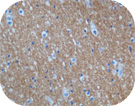Oral Bacteria Suspected as Multiple Sclerosis Trigger
Oral Bacteria Suspected as Multiple Sclerosis TriggerNew research suggests a common oral bacterium may play a central role in triggering or exacerbating autoimmune disease, such as the immune system’s attacks on the brain and spinal cord common to multiple
Oral Bacteria Suspected as Multiple Sclerosis Trigger
 New research suggests a common oral bacterium may play a central role in triggering or exacerbating autoimmune disease, such as the immune system’s attacks on the brain and spinal cord common to multiple sclerosis (MS).
New research suggests a common oral bacterium may play a central role in triggering or exacerbating autoimmune disease, such as the immune system’s attacks on the brain and spinal cord common to multiple sclerosis (MS).
The findings reported by Frank C. Nichols, William J. Housley, Catherine A. O’Conor, Thomas Manning, Shuang Wu and Robert B. Clark, “Unique Lipids from a Common Human Bacterium Represent a New Class of TLR2 Ligands Capable of Enhancing Autoimmunity,” appears in the December 2009 issue of The American Journal of Pathology.
Porphyromas gingivalis, a common oral bacterium in humans, produces a unique type of lipid, phosphorylated dihydroceramides (DHCs), which enhance inflammatory responses. To determine if these lipids accentuate immune-mediated damage in autoimmune disease, researchers led by Robert B. Clark, MD, and Frank C. Nichols, DDS, PhD, of the University of Connecticut Health Center administered phosphorylated DHCs in a mouse model of MS.
The severity of disease was significantly enhanced by the addition of these lipids in a manner that was dependent on activation of the immune system. These data suggest that phosphorylated DHCs from bacteria commonly found in humans may trigger or increase the severity of autoimmune diseases such as MS.
The authors state: “while it is clear that the immune system in most individuals has the potential to attack self-tissues, the ‘tipping’ factors that initiate and propagate autoimmune diseases such as MS in only a subset of individuals remain unknown. Overall, [their] results represent the first description that phosphorylated DHCs derived from common human bacteria are capable of enhancing autoimmune disease.”
Thus, these lipids may function as “tipping” factors, playing a previously unrecognized role in initiating or exacerbating human autoimmune diseases.
In future studies, Clark and colleagues plan to characterize the effects of phosphorylated DHCs on specific cells of the immune system and to identify how and where these lipids are deposited in tissues throughout the body. In addition to the role of these lipids in triggering and worsening MS, the authors believe that phosphorylated DHCs may have the potential to serve both as new markers of MS disease activity and as new targets for therapeutic intervention.
MS affects nearly 1 in 700 people in the United States. Patients with MS have a variety of neurological symptoms, including muscle weakness, difficulty moving, and difficulty with speech.
Source: American Journal of Pathology

